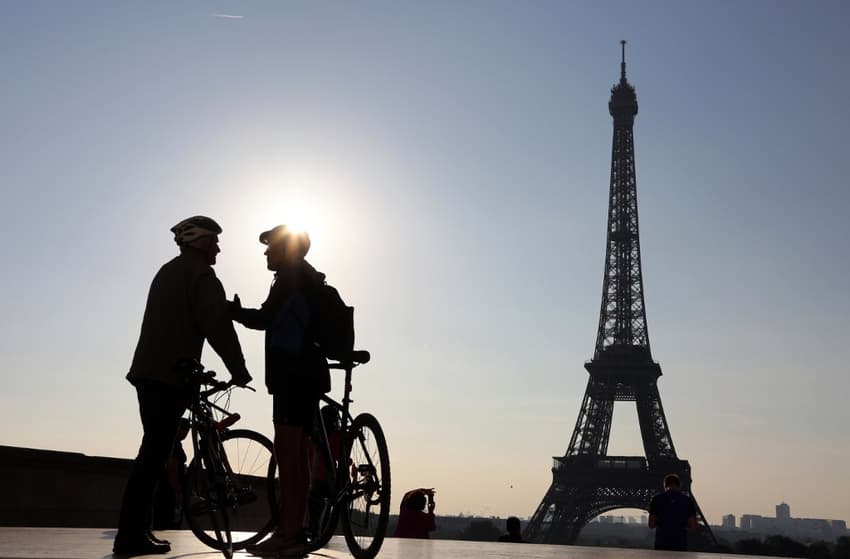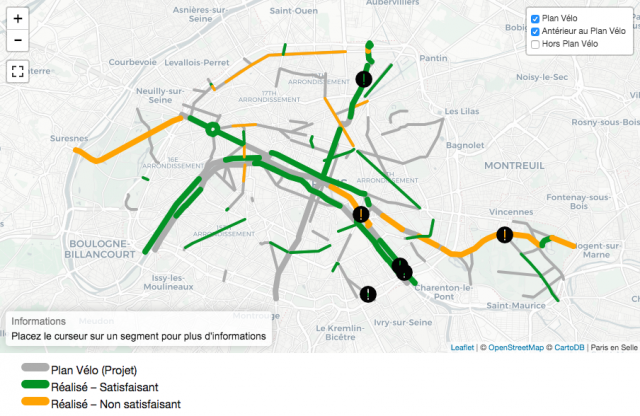Why cyclists in Paris are more numerous than ever

"You are more likely than ever to travel by bike", the French capital’s deputy mayor has told Parisians. Here’s why cycling in Paris is going places.
More than 200,000 Parisians rode their bikes on October 13th, a milestone figure that’s available thanks to the newly installed counter meters (unveiled on September 4th) keeping count on this growing trend as Paris pushes to ditch the cars and go green.
"On average the number of bicycles being used increased by 54 percent between September 2018 and September 2019 in 56 sites equipped with meters," said Christophe Najdovski ,deputy Paris mayor in charge of transport.
“The main rise in usage has been along Rue Lafayette (53 percent) in the 9th and 10 arrondissement, around Quai François Mauriac in the 13th (66 percent) and on rue Voltaire in the 11th (82 percent).
Paris transport authorities say “vélotaf” - which combines the words for bike in French and the slang for work in reference to commuting by bike - has become the most common reason for Parisians to get on their bikes.
?Vous êtes plus nombreux que jamais à vous déplacer à #vélo ! ??♂️??♂️
✅En moyenne,➕54% entre septembre 2018 et septembre 2019 sur 56 sites équipés de compteurs.
✅Sur la même période :
➕53% sur la piste cyclable de la rue Lafayette
➕66% quai François Mauriac
➕82% bd Voltaire pic.twitter.com/fYzkg4Z5Sz
— Christophe Najdovski (@C_Najdovski) 14. října 2019
So why do so many Parisians now prefer to cycle rather than drive their own cars or hop on public transport? And why is the cycling trend likely to spread even further?
More bike lanes to be unveiled
Paris authorities are investing in building new cycle paths and improving the existing ones across the city.
According to the city’s Observatoire du Plan Vélo (Cycle Plan Observatory), the most anticipated routes are on rue Rivoli between Bastille and la Concorde (about 4 km long), the under-construction bike lane between Châtelet and Gare d l’Est (about 2 km), a 2.5 km lane on rue Lecourbe, a 3km one on rue Voltaire and the one running between Gare de l'Est and Stalingrad (about 1 km in length).
There’s also the new RER V cycle network, named after the RER train networks that links Paris and the suburbs, which aims to expand the cycle paths so that cycling to work is a viable option for people who live outside the Paris ring road.
As all too often cycle routes stop at a ring road, the collective behind the scheme envisions "large, comfortable lanes” so that cyclists can “ride without doubt, without danger and over long distances”.
So far, 37 percent of Paris’s new bike lane network has been built.

Click here to access interactive map. Source: Observatorie du Plan Vélo
Paris mayor Anne Hidalgo’s initial aim was to double the number of cycle lanes in Paris from 700km to 1,400km by 2020.
Those plans were however revised down to around 1,000km of lanes to be finalised by next year's spring local elections.
Paris’s cycling influx fits in with nationwide bike plans
Despite the promising shift towards cycling in the capital, only 3 out of every 100 workers in France commute by bike, with commuting by car being the primary means of transport for 70 percent of the working population.
The French government’s mission is to triple the number of cycling commuters in France in the next five years, up to 9 percent by 2024.
In order to achieve this the State will give a total of €350 million to French municipalities that “have bike paths interrupted by other road infrastructure”, such as ring roads, slip roads or any other road meant for bigger vehicles and which could pose a danger to cyclists.
More counter meters to keep track on Paris’s bike trend
Four new "bike counters" will be installed in Cours-la-Reine (8th arrondissement), quai de la Marne (19th), Austerlitz (13th) and Sevastopol (3rd) according to Christophe Najdovksi .
These black and white “totems” as they’re referred to in the French press allow city authorities to keep track of all the people choosing to move around Paris by bike as well as the impact it has on improving traffic and air pollution in the city.
Déjà le 1000ème cycliste à 14h15, seulement 4h après l'inauguration du totem ! Faites des routes et vous aurez des voitures, faites des pistes cyclables et vous aurez des cyclistes #SolutionVélo #PlanVélo pic.twitter.com/rtYDnnCBeg
— Christophe Najdovski (@C_Najdovski) 4. září 2019
Paris transport strikes make cycling more reliable
The one positive outcome of September’s strike-induced travel misery in Paris was the huge number of commuters who took to their bikes instead.
Even the city’s trouble-ridden Vélib bike share scheme managed to record an outstanding 170,000 rides on one of the days of the strike.
Never seen so many people using bikes to get to work in Paris before. This is why @Anne_Hidalgo is digging up the city's roads to put in bike lanes, much to the anger of motorists and many residents. Will Parisians embrace a two wheel future? #greveratp pic.twitter.com/L1ibpjNAR0
— Ben McPartland (@McPBen) September 13, 2019
With the possibility of more transport strikes in December, commuters are likely to migrate in greater numbers to a means of transport they can rely on.
Comments
See Also
More than 200,000 Parisians rode their bikes on October 13th, a milestone figure that’s available thanks to the newly installed counter meters (unveiled on September 4th) keeping count on this growing trend as Paris pushes to ditch the cars and go green.
"On average the number of bicycles being used increased by 54 percent between September 2018 and September 2019 in 56 sites equipped with meters," said Christophe Najdovski ,deputy Paris mayor in charge of transport.
“The main rise in usage has been along Rue Lafayette (53 percent) in the 9th and 10 arrondissement, around Quai François Mauriac in the 13th (66 percent) and on rue Voltaire in the 11th (82 percent).
Paris transport authorities say “vélotaf” - which combines the words for bike in French and the slang for work in reference to commuting by bike - has become the most common reason for Parisians to get on their bikes.
?Vous êtes plus nombreux que jamais à vous déplacer à #vélo ! ??♂️??♂️
— Christophe Najdovski (@C_Najdovski) 14. října 2019
✅En moyenne,➕54% entre septembre 2018 et septembre 2019 sur 56 sites équipés de compteurs.
✅Sur la même période :
➕53% sur la piste cyclable de la rue Lafayette
➕66% quai François Mauriac
➕82% bd Voltaire pic.twitter.com/fYzkg4Z5Sz
So why do so many Parisians now prefer to cycle rather than drive their own cars or hop on public transport? And why is the cycling trend likely to spread even further?
More bike lanes to be unveiled
Paris authorities are investing in building new cycle paths and improving the existing ones across the city.
According to the city’s Observatoire du Plan Vélo (Cycle Plan Observatory), the most anticipated routes are on rue Rivoli between Bastille and la Concorde (about 4 km long), the under-construction bike lane between Châtelet and Gare d l’Est (about 2 km), a 2.5 km lane on rue Lecourbe, a 3km one on rue Voltaire and the one running between Gare de l'Est and Stalingrad (about 1 km in length).
There’s also the new RER V cycle network, named after the RER train networks that links Paris and the suburbs, which aims to expand the cycle paths so that cycling to work is a viable option for people who live outside the Paris ring road.
As all too often cycle routes stop at a ring road, the collective behind the scheme envisions "large, comfortable lanes” so that cyclists can “ride without doubt, without danger and over long distances”.
So far, 37 percent of Paris’s new bike lane network has been built.

Click here to access interactive map. Source: Observatorie du Plan Vélo
Paris mayor Anne Hidalgo’s initial aim was to double the number of cycle lanes in Paris from 700km to 1,400km by 2020.
Those plans were however revised down to around 1,000km of lanes to be finalised by next year's spring local elections.
Paris’s cycling influx fits in with nationwide bike plans
Despite the promising shift towards cycling in the capital, only 3 out of every 100 workers in France commute by bike, with commuting by car being the primary means of transport for 70 percent of the working population.
The French government’s mission is to triple the number of cycling commuters in France in the next five years, up to 9 percent by 2024.
In order to achieve this the State will give a total of €350 million to French municipalities that “have bike paths interrupted by other road infrastructure”, such as ring roads, slip roads or any other road meant for bigger vehicles and which could pose a danger to cyclists.
More counter meters to keep track on Paris’s bike trend
Four new "bike counters" will be installed in Cours-la-Reine (8th arrondissement), quai de la Marne (19th), Austerlitz (13th) and Sevastopol (3rd) according to Christophe Najdovksi .
These black and white “totems” as they’re referred to in the French press allow city authorities to keep track of all the people choosing to move around Paris by bike as well as the impact it has on improving traffic and air pollution in the city.
Déjà le 1000ème cycliste à 14h15, seulement 4h après l'inauguration du totem ! Faites des routes et vous aurez des voitures, faites des pistes cyclables et vous aurez des cyclistes #SolutionVélo #PlanVélo pic.twitter.com/rtYDnnCBeg
— Christophe Najdovski (@C_Najdovski) 4. září 2019
Paris transport strikes make cycling more reliable
The one positive outcome of September’s strike-induced travel misery in Paris was the huge number of commuters who took to their bikes instead.
Even the city’s trouble-ridden Vélib bike share scheme managed to record an outstanding 170,000 rides on one of the days of the strike.
Never seen so many people using bikes to get to work in Paris before. This is why @Anne_Hidalgo is digging up the city's roads to put in bike lanes, much to the anger of motorists and many residents. Will Parisians embrace a two wheel future? #greveratp pic.twitter.com/L1ibpjNAR0
— Ben McPartland (@McPBen) September 13, 2019
With the possibility of more transport strikes in December, commuters are likely to migrate in greater numbers to a means of transport they can rely on.
Join the conversation in our comments section below. Share your own views and experience and if you have a question or suggestion for our journalists then email us at [email protected].
Please keep comments civil, constructive and on topic – and make sure to read our terms of use before getting involved.
Please log in here to leave a comment.